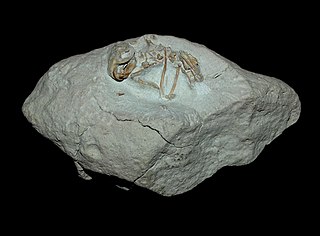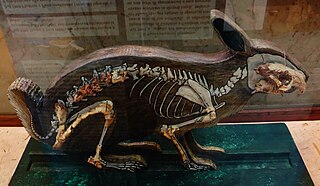
A pika is a small, mountain-dwelling mammal native to Asia and North America. With short limbs, a very round body, an even coat of fur, and no external tail, they resemble their close relative, the rabbit, but with short, rounded ears. The large-eared pika of the Himalayas and nearby mountains lives at elevations of more than 6,000 m (20,000 ft).

The family Aplodontiidae also known as Aplodontidae, Haplodontiidae or Haploodontini is traditionally classified as the sole extant family of the suborder Protrogomorpha. It may be the sister family of the Sciuridae. There are fossils from the Oligocene until Miocene in Asia, from Oligocene in Europe and from the Oligocene until the present in North America, where there is the only living species: the mountain beaver.

Eomyidae is a family of extinct rodents from North America and Eurasia related to modern day pocket gophers and kangaroo rats. They are known from the Middle Eocene to the Late Miocene in North America and from the Late Eocene to the Pleistocene in Eurasia. Eomyids were generally small, but occasionally large, and tended to be squirrel-like in form and habits. The family includes the earliest known gliding rodent, Eomys quercyi.

Heliscomyidae is a family of extinct rodents from the mid-Tertiary of North America related to pocket gophers and kangaroo rats and their relatives. The family contains four genera, Apletotomeus, Heliscomys, Passaliscomys, and Tylionomys. McKenna and Bell (1997) placed the first two genera in synonymy, with Heliscomys as the senior synonym.
Armintomys is an extinct genus of rodent from North America related to jerboas and jumping mice. It is the only genus in the family Armintomyidae. It lived during the early Eocene, and is the oldest known example of a hystricomorphous zygomasseteric dentition. In addition, Armintomys is also the oldest known rodent that had an incisor enamel transition from pauciserial to uniserial. Its remains have only been found in the Wind River Basin in Wyoming, and could be found there during the species' existence on Earth. It was previously assumed that Armintomys belonged to the Dipodoidea family, but has since been understood to have been part of an early radiation of dipodoid rodents, but was not directly ancestral to any later dipodoids, thus it was recategorized into its own family.

The John Day Formation is a series of rock strata exposed in the Picture Gorge district of the John Day River basin and elsewhere in north-central Oregon in the United States. The Picture Gorge exposure lies east of the Blue Mountain uplift, which cuts southwest–northeast through the Horse Heaven mining district northeast of Madras. Aside from the Picture Gorge district, which defines the type, the formation is visible on the surface in two other areas: another exposure is in the Warm Springs district west of the uplift, between it and the Cascade Range, and the third is along the south side of the Ochoco Mountains. All three exposures, consisting mainly of tuffaceous sediments and pyroclastic rock rich in silica, lie unconformably between the older rocks of the Clarno Formation below and Columbia River basalts above.

The Mylagaulidae or mylagaulids are an extinct clade of sciuromorph rodents nested within the family Aplodontiidae. They are known from the Neogene of North America and China. The oldest member is the Late Oligocene Trilaccogaulus montanensis that lived some 29 million years ago (Mya), and the youngest was Ceratogaulus hatcheri—formerly in the invalid genus "Epigaulus" —which was found barely into the Pliocene, some 5 Mya.

Cormohipparion is an extinct genus of horse belonging to the tribe Hipparionini that lived in North America during the late Miocene to Pliocene. They grew up to 3 feet long.
?Oryzomys pliocaenicus is a fossil rodent from the Hemphillian of Kansas, central United States. It is known from a single mandible with the back part missing. All three molars are present, but very worn. Together, the molars are 3.6 mm long. The fossil was discovered in 1935 and described in 1939 as a possible species of Oryzomys. Later authors doubted this allocation and suggested that it may instead belong in Bensonomys or Jacobsomys, but the material may not allow a definite identification.
Metaliomys is an extinct genus of Heteromyidae that existed in the United States during the Late Miocene period. The only species is Metaliomys sevierensis.
Diprionomys is an extinct genus of Heteromyidae that existed in the United States during the Late Miocene period.
Paronychomys is an extinct genus of Cricetidae that existed in Arizona during the Hemphillian period.
Repomys is an extinct genus of Cricetidae that existed during the late Hemphillian and Blancan periods.

Hypolagus is an extinct genus of lagomorph, first recorded in the Hemingfordian of North America. It entered Asia during the early Turolian and spread to Europe not much later, where it survived until the Middle Pleistocene. Though unknown in the Iberian Peninsula, fossils of this genus have been found in the Balearic Islands, suggesting an eastern migration during the dry period in the Mediterranean region known as the Messinian Salinity Crisis.
This paleomammalogy list records new fossil mammal taxa that were described during the year 2013, as well as notes other significant paleomammalogy discoveries and events which occurred during that year.

The Ash Hollow Formation of the Ogallala Group is a geological formation found in Nebraska and South Dakota. It preserves fossils dating back to the Neogene period. It was named after Ash Hollow, Nebraska and can be seen in Ash Hollow State Historical Park. Ashfall Fossil Beds State Historical Park is within this formation.

The Valentine Formation is a geologic unit formation or member within the Ogallala unit in northcentral Nebraska near the South Dakota border. It preserves fossils dating to the Miocene epoch of the Neogene period and is particularly noted for Canid fossils. This unit consists of loosely-consolidated sandstone that crumbles easily. These sands carry the water of the Ogallala Aquifer and is the source of much of the water in the Niobrara River. A particular feature of the Valentine is lenticular beds of green-gray opaline sandstone that can be identified in other states, including South Dakota, Nebraska, Kansas, and Colorado. Although three mammalian fauna stages can be mapped throughout the range of the Ogallala, no beddings of the Ogallala are mappable and all attempts of formally applying the Valentine name to any mappable lithology beyond the type location have been abandoned. Even so, opaline sandstone has been used to refer to this green-gray opalized conglomerate sandstone that is widely found in the lower Ogallala Formation.
This paleomammalogy list records new fossil mammal taxa that were described during the year 2011, as well as notes other significant paleomammalogy discoveries and events which occurred during that year.
This paleomammalogy list records new fossil mammal taxa that were described during the year 2010, as well as notes other significant paleomammalogy discoveries and events which occurred during that year.
This paleomammalogy list records new fossil mammal taxa that were described during the year 2015, as well as notes other significant paleomammalogy discoveries and events which occurred during that year.









